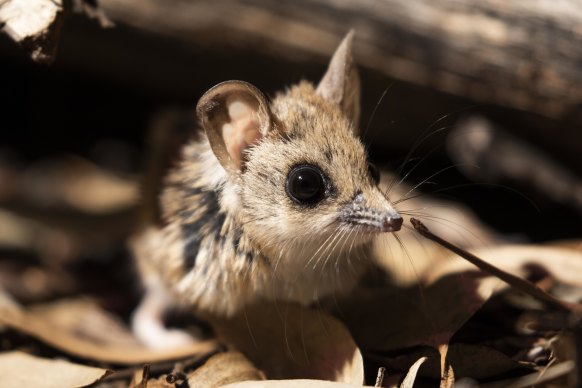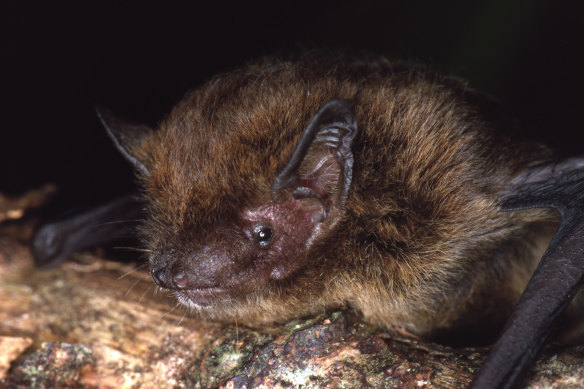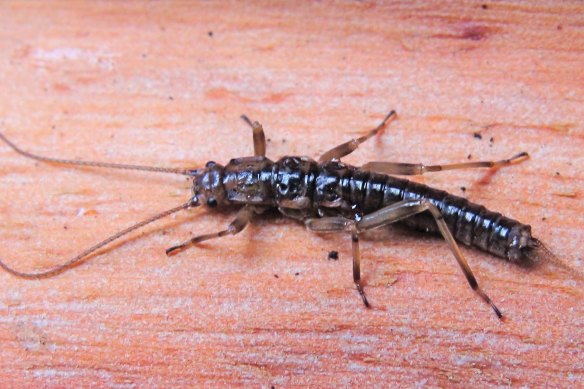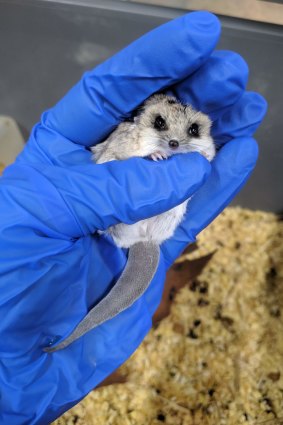
They’re fierce, carnivorous and weigh as much as three grapes, with a stubby tail where they store energy like a camel’s hump.
The tiny, nocturnal fat-tailed dunnart shelters under rocks in the dwindling native grasslands of Victoria, and sometimes shares a nest with mice for warmth over winter before they turn on their bedfellows and eat them.
Researcher Emily Scicluna holds a fat-tailed dunnart.Credit:John Jiang
When Emily Scicluna went looking for Victoria’s fat-tailed dunnarts during her doctoral research they were believed to be “common” in grasslands and woodlands, based on historical records. But this is no longer the case.
These marsupials are one of a number of unique animals that scientists and conservationists want the Victorian government to recognise are in peril in the hope this will trigger plans for their recovery.
Scicluna, a research associate at the University of Melbourne, decided she would start her search at the Werribee Western Treatment Plant, more commonly known as the Werribee sewage farm.
There were 700 fat-tailed dunnarts trapped there over four years in the 1970s, but when using the same methods recently, Scicluna found none. In four decades, 75 per cent of suitable dunnart habitat at this site had been cleared.
Fat-tailed dunnarts are tiny carnivorous predators that live in Victoria’s grasslands but whose numbers have dwindled to dangerous levels. Credit:Caleb McElrea Media
Even when she extended her search further west into Victoria’s remnant grasslands, fat-tailed dunnarts were still present, but in very low numbers.
“The situation is critical; dunnarts are under serious threat of extinction,” says Scicluna. “Without listing the fat-tailed dunnart as vulnerable, we could lose yet another precious Australian marsupial to extinction.”
Australia is sadly the mammalian extinction capital of the world. Thirty-nine land mammals have been lost since European settlement, which is a rate of about one or two mammal species per decade since the 1840s.
Members of the public or organisations can make nominations for the Victorian government to consider species for listing, but it is a challenging process for lay people.
The Christmas Island pipistrelle batwas once abundant but is now extinct. Credit:Lindy Lumsden
Other species are also being considered for protection. The Victorian National Parks Association (VNPA) recently lodged an application to protect the habitat of a cryptic insect called the Mount Donna Buang wingless stonefly.
This stonefly is critically endangered and only known to occur within shallow streams in a few square kilometres of Victoria’s central highlands, on top of Mount Donna Buang, near Warburton on Melbourne’s eastern fridge.
Its presence prompted the former Victorian planning minister Lizzie Blandthorn to reject major sections of proposed world-class mountain bike tracks within the Mount Donna Buang national park. But the association wants the government to go a step further and approve only the mountain bike tracks that run through the less-fragile state forest.
The push to protect the insect’s habitat is the first test of a legal provision in state environmental laws introduced in 2020.
A male Mount Donna Buang wingless stonefly. Credit:Eddie Tsyrlin
“The Mount Donna Buang stonefly is a truly remarkable creature staring down the barrel of extinction,” VNPA spokesperson Matt Ruchel said. “We simply can’t wait any longer to ensure every measure is taken to protect this incredible stonefly, which exists nowhere else in the world.”
Unfortunately, getting species declared as threatened doesn’t necessarily guarantee action. A hard-hitting Auditor-General’s review of Victoria’s environment department in 2021 found only 20 per cent of the state’s 2000 threatened species had action plans, which are supposed to guide their protection.
A fat-tailed dunnart.Credit:Emily Scicluna
And an inquiry into Victoria’s ecosystems decline in the same year was told it would take five years to develop “action statements” for all listed species, which outline actions required to protect and recover threatened species.
Dr Adrian Marshall, an urban ecologist and facilitator of the Grassy Plains Network, said the fat-tailed dunnart’s declining numbers were predominantly caused by destruction of its habitat, as farmers switched from grazing to cropping, and development continued in the remnant grasslands.
“Listing means developers and others have to take it into account [when] they want to clear land,” Marshall said.
Data from Scicluna’s research shows the Victorian dunnart population had declined by more than 60 per cent from 2000-09 to 2010-19. This has convinced the Victorian government’s Scientific Advisory Committee to support the nomination of the fat-tailed dunnart, and she hopes it will be formally listed.
“In under 200 years we have decimated the once-bountiful grasslands of the Victorian volcanic plain after traditional custodians cared for the environment for 60,000 years,” she said.
The Scientific Advisory Committee has accepted the recommendation that the fat-tailed dunnart be recognised as threatened, with the final decision to be made by the Minister for Environment Ingrid Stitt and the Minister for Agriculture Gayle Tierney.
Get to the heart of what’s happening with climate change and the environment. Our fortnightly Environment newsletter brings you the news, the issues and the solutions. Sign up here.
Most Viewed in Environment
From our partners
Source: Read Full Article




